| Français | Contact Us | Help | Search | Canada Site | |
| Home | News Releases | Key Rural Initiatives |
Site Map | Publications |
Canadian Rural Partnership Research and Analysis 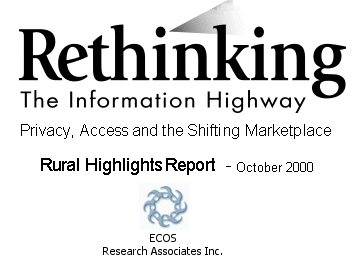
1 INTRODUCTION 1.1 BACKGROUND Given the now ubiquitous dot-com, it is clear that the Internet is rapidly emerging as the backbone of the information highway and one of the most popular technologies since the introduction of television. Unlike television, however, the Internet transcends the boundaries of work, school and home and creates a new and more dynamic way for people from diverse and distant communities to communicate with one another. It is apparent upon examining recent trends that, for most Canadians (certainly the mainstream), it is no longer a question of whether or not they are moving online. The important questions relate to who is online, what they are doing, and what are their expectations and preferences in the use and development of new applications, as well as barriers and bridges to their adoption. Answering these questions will help to guide decisions about the types of services that governments and other organizations will offer, how they will deliver such services and how to successfully address the widely prevalent, and somewhat extreme, concerns about security and privacy. Drawing upon EKOS' Rethinking the Information Highway study, this report provides an overview of the differences between rural and urban Canadians when it comes to the information highway. In doing so, the report also situates these differences within the context of the major findings from the broader study itself. Launched in 1997, the Rethinking the Information Highway study has been designed as a broader initiative rather than restricting itself to the Internet. The study is intended to develop a more rigorous understanding of the emerging trends surrounding the information highway. 1.2 METHODOLOGY The findings in this report are based on the results from two surveys with Canadians aged 16 and over - a benchmark telephone survey and a follow up self-administered mailback survey. The benchmark survey included a national random sample of 5,014 Canadians, and was conducted between June 9 and July 9, 1999. This sample included 1,335 respondents in rural areas and 3,678 respondents in urban areas.
The mailback survey was sent to 3,560 participants from the benchmark survey that had agreed to a follow-up survey.
For the purposes of this report, the findings have been segmented on a rural and urban basis according to the postal code associated with the telephone number of an individual called. Postal codes with a zero in the second position are defined as rural (e.g., K0A 1S4). Other postal codes are defined as urban. 2 RURAL CANADIANS AND THE INFORMATION HIGHWAY As the information highway weaves its way across the social and economic landscape, it is clear that it involves the spread of a wide spectrum of increasingly sophisticated technologies in the daily lives of Canadians - in the home, at work and school, and all points in between. Whether they live in rural or urban areas, Canadians in all walks of life are adopting these technologies in an equally complex array of applications. There are nevertheless some important differences between rural and urban Canadians with respect to access, usage and penetration of these technologies and applications. This section provides an overview of the study's key findings with respect to these issues, and explores what differences exist between rural and urban populations. 2.1 PENETRATION, ACCESS AND CONNECTIVITY IN RURAL CANADAUsage of many technologies is lower in rural Canada, although the differences are relatively small in some areas With the exception of satellite television, rural Canadians generally reported lower levels of technology usage when compared to their urban counterparts [Exhibit 2.1]. The greatest difference was between television services, with a large amount of the drop in cable usage offset by higher satellite usage in rural Canada. As shown in Exhibit 2.1, usage of the Internet and computer-related technologies are noticeably lower with rural Canadians, although the differences were not as pronounced as among those found across income, age and educational subgroups (discussed in the next section).  Rural-urban differences with Internet-related technology usage are far less pronounced than those found along demographic lines While there were noticeable differences in usage of the Internet and computers between rural and urban Canada, they were much less pronounced than those found along generational, income and education lines. For instance, 74 per cent of those with household incomes of $60,000 and over reported personal computer usage compared to only 36 per cent of those with household incomes under $20,000. Measured across urban and rural populations, this difference was only 63 per cent and 54 per cent, respectively. Regardless of which Internet-related technology or application that is examined, the differences across age, income and education lines are far stronger than those seen with rural and urban differences. In short, these demographic variables are more important influences on the usage of these technologies than whether or not one lives in a rural or urban community. These differences are summarized in Table 2.1.
Furthermore, rural Internet usage has increased substantially, while other technologies showed little or no change (with the exception of wireless phones) Between 1997 and 1999, usage of personal computers, cable television, telephone banking and satellite television among rural Canadians has been relatively stagnant with only modest growth at most. In contrast, however, there was a sizeable increase in the proportion of rural Canadians reporting recent usage of the Internet and, to a lesser extent, wireless phones [Exhibit 2.2]. These findings mirror trends in urban Canada that also showed little growth for personal computers but significant growth in the usage of wireless phones and the Internet over the same period.  National results show an increase of 14 percentage points for Internet usage (from 37 to 51 per cent) during this period. The increase in wireless phone usage on a national level was statistically insignificant (from 43 to 44 per cent). The increase indicated for rural telephone banking and satellite television was also relatively small. Neither e-mail nor Internet/PC banking were measured in the earlier study. The increase indicated for rural telephone banking and satellite television was also relatively small. Neither e-mail nor Internet/PC banking were measured in the earlier study. Rural Canadians attach less importance to various technologies when compared to their urban counterparts With the exception of wireless phone service, rural Canadians consistently attached less importance to technological products and services. As shown in Exhibit 2.3, there were significant differences between the proportion of rural and urban Canadians attaching importance to various products and services. In fact, these differences more or less mirrored the differences in usage levels for each technology between rural and urban subgroups. Exhibit 2.3
Perceived Importance of Technologies (Urban vs Rural) "How important is it to your household to have the following products or services?" 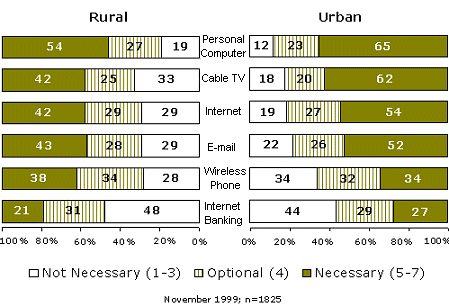 Without question, the relative importance assigned to the technologies and applications by rural and urban Canadians are a reflection of their levels of usage. The lower importance of cable television for rural Canadians is indicative of the lower usage of this service. Likewise, the similar importance assigned to wireless phone service is a reflection of the similar usage levels among rural and urban subgroups. The significance of usage to the perceived importance of various technologies is clearly seen by looking at results broken down by user and non-users. For instance, almost three quarters of Internet users (74 per cent) say the Internet is necessary. Conversely, almost three quarters of non-users (71 per cent) feel that the Internet is either optional or not necessary. Rural penetration rates for many technologies are significantly lower, although the incidence of others is similar Examining penetration rates for various technologies and applications, the findings point to lower incidences of personal computers and Internet access among rural Canadians. These differences are summarized in Table 2.2. This is also the case with the penetration of answering/voice machines that are noticeably higher in urban Canada. On the other hand, there are no significant differences in penetration for either wireless phones or call display.
Compared to other socio-economic differences for Internet penetration rates, rural and urban differences are significantly smaller As discussed in the previous section, differences exist in home Internet access between rural and urban Canada. While significant, these differences were much less pronounced that those along income, age and education lines [Exhibit 2.4].  For instance, the difference between the youngest and oldest generational subgroups was 37 percentage points, compared to only 12 percentage points between rural and urban Canadians. Rural households with Internet access are slightly more likely to have moved online within the past two years Generally speaking, Internet access from home continues to be a relatively new feature of the typical household. As shown in Table 2.3, slightly more than half of Canadians (53 per cent) with home Internet access have been connected for less than two years. While relatively small, urban Canadians are slightly more likely to have had access for longer - 48 per cent of those in urban areas have had access for more than two years, compared to 41 per cent in rural areas.
While the vast majority are still using regular dial up connections, this is even more pronounced among rural households Overall, only a small minority of Internet homes reported broad-band Internet access in June 1999. As the availability of high-speed connections continue to be more limited in rural areas, it is not surprising that even fewer respondents in rural Canada reported high-speed connections. Fewer than one in ten (six per cent) rural households reported broadband access compared to 17 per cent among their urban counterparts [Table 2.4].
Only a small minority reported long distance charges with Internet access, although many others are not sure As shown in Exhibit 2.5, only one per cent of all Canadians report incurring long distance charges with their home Internet access. Not surprisingly, this rises in rural areas and reaches 5 per cent.  On the other hand, a surprisingly large number of those with home Internet access reported that they do not know whether or not long distance charges apply to their home Internet accounts. 2.2 INTERNET USAGE (LOCATION, INTENSITY AND FREQUENCY) Rural Canadians were less likely to use the Internet at work, but otherwise their location of usage was virtually identical to that of urban Canadians Home is easily the most significant location of usage for both rural and urban populations. While significantly less important, the levels of usage at school and public access sites were also very similar for rural and urban Canadians [Exhibit 2.6]. Other locations, such as friends or family, were also equally reported by rural and urban subgroups.  By contrast, there was a significant drop in usage at work for rural Canadians - a full ten percentage points less than urban users. This difference was even more pronounced when compared to other demographic subgroups. For instance, while 32 per cent of rural Canadian Internet users used the Internet at work, this number jumps to 55 per cent for upper income households ($60,000 and over), 51 per cent for those aged 25 to 44, and 55 per cent for university educated Canadians. Rural Canadians, much like their urban counterparts, have greatly increased their usage of the Internet from home Growth of Internet usage at home for rural Canadians far outstripped other locations during the period between September 1997 and June 1999 [Exhibit 2.7]. Overall, there was significant growth in usage at home for both urban and rural Internet users. The increase for rural users (20 percentage points) was slightly greater than that for urban users (16 percentage points).  Despite some growth in workplace usage, the increase was relatively modest when compared to home usage. There was a seven percentage point increase in usage at work between the fall of 1997 and June 1999 for rural Internet users. Urban users reported a similar level of increase at work over the same period, from 34 per cent to 42 per cent. Usage at both public access sites and school was relatively unchanged for both rural and urban Internet users. Whether rural or urban, home users go online with the same frequency Underscoring the significance of home usage, the frequency of usage amongst those with home access is more or less the same for both rural and urban subgroups [Table 2.5]. For both groups, the vast majority use at least once a week and almost half use "daily or almost daily."
On the other hand, there are some signs that rural Internet users spend more hours online, although this is a fast evolving area While few differences are observed between the frequency with which rural and urban Internet users go online, there are some signs that rural users spent more time online captured by the average number of hours using the Internet at home and at home in the past week. As shown in Table 2.6, rural users reported more hours spent online at home, although it was a smaller proportion (30 per cent vs. 43 per cent with some time online in urban areas). When it comes to hours spent online at work, rural users again reported more hours, although the differences are not statistically significant. Overall, both groups spend more time using the Internet at home than they do at work each week. This is a fast evolving area, and it will be important to see how this trend unfolds and, whether or not, rural users do in fact continue to report more hours spent online.
2.3 RURAL CANADIANS AND E-COMMERCE Rural Internet users are somewhat less likely than those in urban Canada to have purchased online, but more likely than many other subgroups While rural Internet users are below average in online purchases overall, they are not far behind their urban counterparts. In fact, many other demographic subgroups lag much further behind in terms of online purchases [Exhibit 2.8]. There is only a four percentage point difference between urban and rural Canadians. This is quite minimal when compared to differences across gender (14 percentage points) or between the highest and lowest income or educational groups (21 and 14 percentage points, respectively).  The significance of this finding is further minimized by the incidence of recent online purchases within the past three months. Rural Canadians actually reported higher incidences of recent online purchases in the past three months (64 per cent) than did urban Canadians (58 per cent). It should be noted, however, that this finding is not statistically significant due to the small numbers of online purchasers. It nevertheless suggests that those who have purchased online are equally almost as likely to have done so recently regardless of whether or not they are urban or rural residents. Rural Internet users are inclined to emphasize somewhat different reasons for not having purchased online 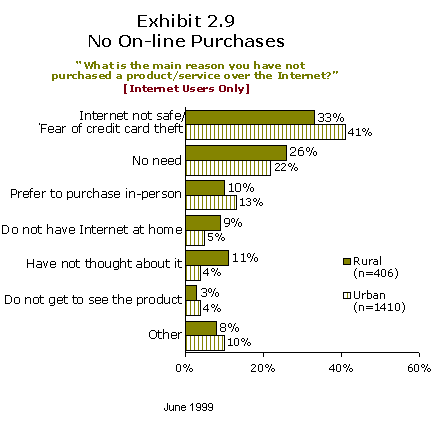 When probed on the reasons for not purchasing online, rural Canadians are somewhat less likely than their urban counterparts to cite security and safety of transacting information. That being said, however, this reason is still the most commonly cited reason for both rural and urban Canadians [Exhibit 2.9]. In contrast, rural Internet users are more likely to indicate that not having thought about it before, they have no need or do not have home access. Rural Canadians are less comfortable with the notion of submitting credit card numbers online, although urban Canadians also report low comfort 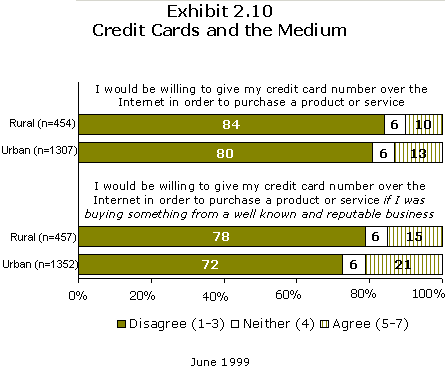 Rural Canadians are somewhat less likely to submit their credit card number over the Internet for the purpose of purchasing a product or service. Not unlike urban Canadians, there is only a marginal improvement in the number willing to do so if this involves a reputable and well-known business [Exhibit 2.10]. 2.4 FUTURE DEVELOPMENTS IN RURAL INTERNET USAGEExpectations for going online generally fall in line with current trends in home Internet access Overall, more than one in four households reporting no home access to the Internet (27 per cent) in June 1999 expected to come online within the next year [Exhibit 2.11]. 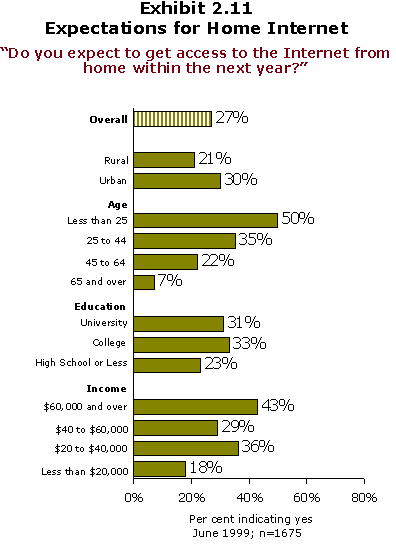 As with current home access demographics, differences in expectations are much more pronounced along generational lines. On the other hand, the differences are less pronounced along education and income lines (with the exception of the lowest income groups), and are similar to those between rural and urban Canadians. A lack of confidence in the skills needed to use the Internet presents a barrier to usage for many Canadians, including those from rural areas Lacking confidence in computer skills can be a significant barrier preventing Canadians from going online. Most Canadians believe these skills are inferior to their own basic literacy skills which most rated as being above average. This is particularly true for lower income, lesser-educated and older Canadians, as well as those from rural areas.  Rural Canadians express significantly lower levels of confidence in both their computer and Internet navigation skills. As shown in Exhibit 2.12, rural Canadians are much more likely to rate their computer and Internet skills as poor, regardless of the time frame. Between September 1997 and June 1999, there have been modest improvements in skill confidence levels with computers for both rural and urban Canadians. When it comes to basic Internet skills, the increase was slightly more pronounced for both groups. Significantly, there is an almost direct relationship between those subgroups reporting low levels of confidence in their computer skills and those with low levels of computer and Internet usage. Clearly, skills, or at least confidence in skills, can be a significant barrier to usage. 3 RURAL CANADIANS AND E-GOVERNMENT As the century comes to a close, it appears that an entirely new way for citizens to interact with their governments is emerging as the Internet continues to proliferate. The movement towards electronic government or e-government has not simply meant a different means of interacting but also a more intensive form of interaction. Information about government is infinitely more accessible to those online than those not, particularly in terms of the rapidity with which it can be obtained. What is being witnessed is the emergence of the e-citizen and the potential to be a much more informed and engaged citizen. This chapter explores these issues as they pertain to emerging differences between rural and urban Canadians. 3.1 RURAL CANADIANS AND CONTACT WITH GOVERNMENTRural Canadians are just as likely as their urban counterparts to have had recent contact with the federal government Before trying to understand how electronic as well as other service delivery channels are viewed by rural Canadians, it is useful to examine the extent to which citizens have contact with the federal government and the way they are doing so. While most citizens will come into direct contact with the federal government at some point, far fewer have done so recently. As shown in Table 3.1, about two thirds of the general public have not had any contact with the federal government within the past three months for personal reasons. The remaining third have had at least one contact, with about one in ten Canadians having four or more contacts. The level of recent contact shows no significant differences across rural and urban subgroups.
While the level of contact does not differ between rural and urban Canadians, there are some differences in the method of contact There are significant differences in the method that urban and rural Canadians use to contact government. Nevertheless, it must be recognized that telephone and mail still remain far more important means of interaction than the Internet, e-mail or even in-person contact for both groups. As shown in Exhibit 3.1, Canadians are most likely to have used the telephone in their most recent contact with the federal government (with some minor differences between rural and urban populations).  Yet when we turn to the lesser used methods of Internet or e-mail and in-person contact, significant differences arise between rural and urban Canadians. The latter is undoubtedly a result of remote locations in some instances; the former resulting from not only lower levels of adoption with Internet technology but also less experienced usage. Proportionately, urban users have much higher numbers of more experienced users. These users also show much higher levels of usage with different online applications, including using government websites. It is also noteworthy that more citizens - whether urban or rural - have had recent contact with the federal government online than have done so in-person. Less than one in ten reported in-person contact for both subgroups. Rural Canadians' preferences are slightly different than those for urban Canadians, but they are also contingent upon the type of transaction Given that the way in which Canadians most recently had contact may not actually reflect their preferences, the research probed respondents on the way in which they would prefer to interact with the federal government when given the choice. There are clear differences in the preferred method of contact depending on the type of transaction involved (i.e., either obtaining information or applying for a program). In terms of obtaining information, there is a clear preference for either telephone or mail. Fewer indicate a preference to using the Internet, in-person and fax methods of contact. Yet contact for the purpose of obtaining information shows no significant differences between rural and urban subgroups.  The same cannot be said when the purpose of contact involves applying for a program. As shown in Exhibit 3.2, there are significant differences between rural and urban Canadians' preferred method of contact on this front. Not unlike current methods of contact, rural Canadians show a weaker preference towards Internet or email. By contrast, there is a greater emphasis instead on telephone as the preferred method of contact among rural Canadians. 3.2 GOVERNMENT ONLINE AND RURAL CANADIANSBroadly speaking, the Internet is seen as an effective way for governments to reach citizens - a view held by nearly six in ten overall [Exhibit 3.3]. Still, rural Canadians are slightly less enamoured with this method with just over one half seeing the Internet as an effective form of communication. These views are more pronounced among those already online (69 per cent), while less than one in two non-users hold the same outlook (48 per cent). Once again, it is likely that the differences in adoption between rural and urban Canadians is at work in their slightly less favourable view of governments using the Internet. 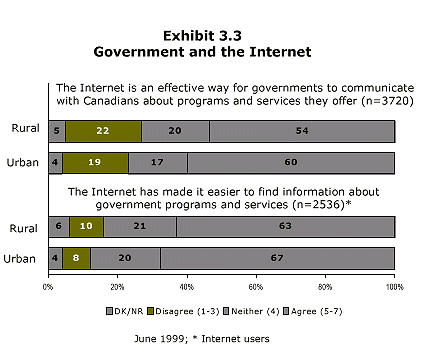 This is also reflected in the slightly lower agreement among rural Internet users in relation to the idea that the Internet has made it easier to find information about government programs and services [see Exhibit 3.]. Given that this question was asked only of Internet users, the differences between urban and rural respondents is not surprisingly somewhat less pronounced that the question about the Internet's effectiveness as a communications vehicle. 3.3 LOOKING TO THE FUTUREA greater emphasis on technology is accepted, but choice remains paramount The overall study findings suggest that there is significant demand for online means of interacting with government and that this demand is growing as more and more Canadians move online. Yet from the public's perspective it is clear that a predominately electronic service delivery network is not what they expect from government. The findings discussed earlier suggest that there will continue to be a demand for different ways to interact with the federal government, including the more traditional methods of the telephone, mail and in-person contact. This is particularly true over the shorter term. In part, this reflects the fact that certain types of transactions lend themselves more naturally to one method of contact than another. Equally important is the fact that Canadians' use of technology remains highly polarized. While this is more apparent across income, educational and generational subgroups, it is also true (albeit to a lesser extent) for rural and urban populations. At least over the foreseeable future, many rural Canadians will neither be comfortable or interested in using some of the newer electronic methods of contact that are currently under development. It is thus paramount that choice of contact methods are maintained for rural Canadians.  That being said, however, there is strong support that the greater emphasis on the use of information technology by governments is seen as a step in the right direction. As shown in Exhibit 3.4, those indicating that it is a step in the "right" direction far outweigh those holding the opposite view by about six to one. Moreover, these positive views cut across both rural and urban lines. 4 RURAL CANADIANS AND PRIVACY Privacy and security of personal information were a significant area of focus for this year's study. In broad terms, the findings pointed towards growing levels of comfort in dealing with privacy issues and a reduced level of concern with privacy on a general level. Moreover, privacy and the concerns over the use of personal information are contingent to a very large extent upon context: the type of information, the type of organization, as well as the rationale for collecting it. As Canadians learn more details about specific transactions of personal information in general, their concerns about privacy tend to subside. Nevertheless, privacy concerns, and specifically those relating to the transaction of personal information, remain very significant. In this chapter we will highlight some of these findings as they pertain to rural Canadians. In some areas, there are some significant differences between rural and urban subgroups. Those differences will provide the focus for this chapter. 4.1 GENERAL PRIVACY CONCERNSRural Canadians are slightly more concerned about privacy issues, but overall concerns are down substantially There are few large differences between the way rural and urban Canadians view privacy issues. Where differences do exist, rural Canadians tend to express slightly higher levels of concern.  As a general indicator of privacy concerns, respondents were asked whether they believed governments or businesses could "learn anything they want" about them. As shown in Exhibit 4.1, a sizeable majority agree with both statements and rural Canadians are slightly more inclined to agree. One of the major findings with respect to privacy, however, is that general concerns about privacy have dropped significantly since the early nineties. In 1992, over 81 per cent of Canadians agreed with the statement about government and 71 per cent agreed with it regarding business. Rural Canadians have similar views towards the issue of governments collecting too much information, although not quite as pronounced When probed on which statement more closely reflects their views, 57 per cent of rural Canadians leaned towards "governments collect far more information than they actually need to when they provide services to Canadians". This compares to only 34 per cent choosing "governments collect only the personal information they need to when they provide services to Canadians" [Exhibit 4.2]. Another 9 per cent were unable to make a judgement on this matter. These views are similar to urban Canadians, albeit not quite as pronounced.  While it is notable that there are slightly more rural Canadians that responded they "don't know" to this line of questioning, the proportion is fairly large for both groups. This is relevant as awareness is a major factor when dealing with privacy issues. Heightened awareness and confidence in dealing with privacy issues tends to bring with it greater levels of comfort. Surprisingly few differences are seen across demographic subgroups. Rural Canadians are somewhat less likely to express confidence in being able to deal with personal privacy issues Another broad finding going hand-in-hand with reduced levels of concern, is a growing sense of confidence in dealing with and awareness of privacy issues. While a sizeable number of Canadians still do not feel they have much recourse in terms of outside help when presented with a privacy problem, this is somewhat less pronounced than at the beginning of the decade.  Similar to their slightly higher levels of concern with privacy, rural Canadians are slightly more likely to agree that they wouldn't know who to turn to if they wanted to do something about an invasion of privacy [Exhibit 4.3]. A third of Canadians say that they lack the confidence in having enough information to know how new technologies affect their privacy. However, this also represents an improvement since the 1992 study. There were more significant differences on this indicator with rural Canadians. While slightly more than half of urban Canadians agree with the second statement (51 per cent), only 44 per cent of rural Canadians express such confidence. 4.2 RURAL CANADIANS AND PERSONAL INFORMATION ONLINERural Canadians are somewhat more concerned about transacting personal information online Perhaps the most significant finding emerging from the study with respect to privacy issues is that concerns have shifted towards the protection of personal information. Concerns are heavily influenced by the type of personal information and the organization with which it is being transacted. There is a definite hierarchy in both the type of information involved and the type of organizations obtaining it. This finding holds equally for both rural and urban Canadians. This focus on personal information has major implications for online transactions. As governments move increasingly towards forms of online service delivery, there will be an increasing need to request personal information online. Rural Canadians express somewhat higher levels of concern with submitting personal information online than those from urban areas. In part, this is a reflection of the lower levels of technology usage with rural Canadians. As individuals become more experienced with using technologies such as the Internet, their concerns about personal information tend to decrease. The very experience of submitting personal information online can itself lead to greater levels of comfort. Less than half of Canadians with Internet experience have ever submitted personal information online, and an even smaller number of rural users Less than half of those who have used the Internet have also submitted personal information online. An even smaller proportion of rural users have done likewise [Exhibit 4.4]. 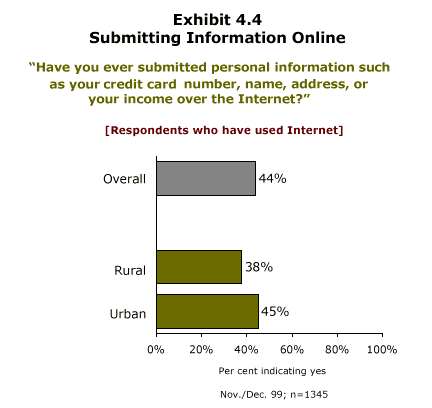 As seen in the previous chapter a smaller proportion of rural users have been online for more than four years. These more seasoned users have higher levels of awareness of various security mechanisms such as encryption and they are also much more likely to partake in more active forms of Internet usage. As a result, these more seasoned users have a higher likelihood of having submitted information online. Given that there is a much larger proportion of such users among the urban subgroup, it is not surprising that they should show higher levels of having had submitted personal information online. Rural Canadians' comfort with submitting personal information online is lower than that seen with urban Canadians (which is in itself quite low) As shown in Exhibit 4.5, only a minority of either urban or rural Canadians who have used the Internet expressed high levels of comfort with providing personal information online. Again, the high comfort zone is weighted fairly heavily with more experienced users, fewer of which can be found among rural Canadians. 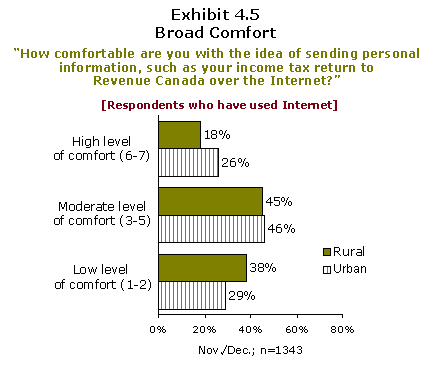 It should be noted that Revenue Canada receives some of the highest trust numbers for organizations that collect personal information. In conclusion, there are few differences between rural and urban Canadians with privacy and security issues. Rural Canadians express somewhat higher levels of concern, but this is largely a reflection of the slightly lower levels of technology usage. 5 CONCLUDING REMARKS Throughout this report it has become clear that rural Canadians are slightly behind their urban counterparts on most technology indicators. Rural Canadians report lower usage of computer and Internet related technologies, as well as lower household penetration for both personal computers and Internet access. Rural Canadians are also less likely to have high-speed Internet access, Internet usage at work and e-commerce experience. Usage and exposure to technology also have a significant impact on attitudinal and other usage indicators. As a result, rural Canadians also report slightly lower expectations for obtaining home access as well as less confidence with computer and Internet navigation skills. The likelihood of contacting the federal government using the Internet as well as the preference for doing so is also lower. Privacy concerns, particularly those involving the transaction of personal information, are also impacted by usage. Willingness to use credit cards over the Internet, engage in e-commerce and confidence in dealing with privacy and technology issues are all positively impacted by increased technology usage. While it is clear that rural Canadians score somewhat lower on these indicators, it is just as apparent that the differences between rural and urban Canadians are, in-themselves, less pronounced than those seen across age, gender, income and educational subgroups. In particular, older Canadians, females, lower income and those with a lower level of educational attainment all sit on the other side of the technological divide (albeit less so than in the past). Other factors not examined in this report that have a more significant impact on technology uptake and the attitudinal indicators examined here include the length of time an individual has been removed from the education system as well as occupational category (e.g., professionals versus unskilled trades people). In terms of looking to the future, it will be important to see to what extent the rural and urban differences narrow, and how quickly. This, in part, will be influenced to some extent by the how differences among demographic groups change. Equally important, despite truly impressive growth, it must be remembered that the movement online is still relatively in its early stages. Continued growth in newer technologies (particularly on the wireless side and in relation to high speed access), as well as newer applications (particularly in relation to e-government and e-commerce) will continue to pull more rural Canadians online.
| ||||||||||||||||||||||||||||||||||||||||||||||||||||||||||||||||||||||||||||||||||||||||||||||||||||||||||||||||||||||||||||||||||||||||||||||||||||||||||||||||||||||||||||||||||||||||||||||||||||||||||||||||||||||||||||||||||||||||||||||||||||||||||||||||||||||||||||||||||||||||||||||||||||||||||||||||||||||||||||||||||||||
